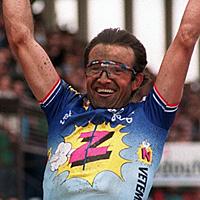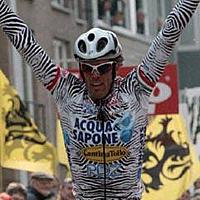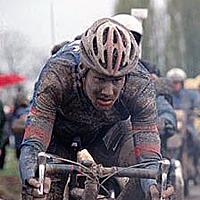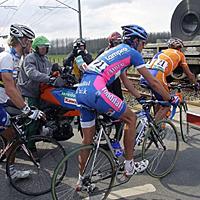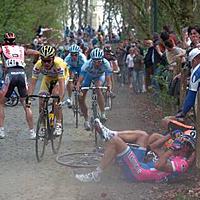
Recently on Cyclingnews.com |
Tales from the peloton, April 7, 2009
Great moments in Classics history - the cobbled Classics
By Cyclingnews staff
 |
There is something about the Classics which makes one sentimental. Perhaps it is the years of history in which these races are steeped: the bone-rattling challenge of the cobbles, the fortitude needed to endure the sometimes hypothermic conditions, the man-to-man battles where only the strongest emerge victorious. All of these elements are combined in the Classics to create a gripping drama that captures the hearts of fans from around the world.
Our staff has chosen a few favourite moments which define the Classics - this first installment consists of ten moments in recent cobbled Classics history which have exemplified the spirit of these great races. We hope you enjoy these memories.
1981 Paris-RoubaixHinault rescues French prideBy Daniel Benson Bernard Hinault's career is long over but the memories he gave the sport will last an eternity. The multiple Grand Tour winner and last true patron of the peloton was strong and brash but always worth watching. He won nearly every Classic, but for me 1981 Paris Roubaix stands out above all others. Not just because he wore the rainbow jersey, or because it came down to a thrilling sprint between six of the best riders in the world, but mainly because Hinault won the race at his very first attempt. It was a display of bravado in which he came, he saw, he conquered, and there was nothing even multiple Roubaix winner Fransesco Moser could do about it. It was a enthralling finale. First Hinault attacked in the final eight kilometres, before Hennie Kuiper brought him back. The Frenchman even had time and strength to crash, remount and chase before rejoining the leaders before the velodrome gates. The group included, Roger De Vlaeminck, Marc Demeyer, Kuiper, Moser, Jean Chassang, Ferdi Van den Haute, René Bittinger and Guido Van Calster. Hinault hit the front with a lap to go and it looked as though he'd gone to early when Demeyer came through on the inside. But Hinault hit the gas again to come past and take France's first Roubaix title in twenty-five years. If you're in any doubt as to how impressive the win was here's the finish in digital format. |
1985 Ronde van VlaanderenVanderaerden triumphs in epic editionBy Peter Hymas Win the Ronde and proudly enter the pantheon of cycling greatness. Win the Ronde as a Belgian, ensconced in the jersey of the reining national champion, finishing alone in front of only 23 other riders (the most diminished peloton since 1950) when you're just 23 years old to boot, then you've achieved the realm of legend. Such was the fate of Ronde winner Eric Vanderaerden on an abysmally frigid and rainy April 7, 1985. He arrived in Meerbeke 50 seconds in front of Aussie teammate Phil Anderson and 1:01 ahead of cagey veteran Hennie Kuiper, himself a 1981 Ronde champion, in a masterful display of grit, power, tactical savvy and raw courage. As is the case in many editions of the Ronde, Vanderaerden's winning move occurred on the cobbles of the Muur - Kapelmuur, where he and Panasonic-Raleigh teammate Anderson caught Hennie Kuiper at the storied climb's base. The Belgian/Aussie duo bridged a 30 second gap to the Dutchman who had been making a concerted solo bid at victory. They left in their midst an elite chase group of eight, including Eddy Planckaert, Sean Kelly, Greg LeMond and Adri Van der Poel. Vanderaerden, still stinging from his loss to Kuiper in Milan-Sanremo the previous month, set a furious tempo up the Muur and, finding a chink in Kuiper's armor, topped the summit with a slim 50 meter gap on the Dutchman and Anderson. Kuiper, exhausted after nearly six and a half hours of racing in driving rain and wind, was powerless to respond. Vanderaerden steadily increased his lead throughout the closing 20 kilometres as he roared to the finish. Anderson, Vanderaerden's dutiful teammate, stayed glued to Kuiper's wheel before making his own attack with 4 kilometres to go to secure a Panasonic-Raleigh one-two. Three days later, Vanderaerden won Gent-Wevelgem to score a rare double, a feat accomplished only two other times by Rik Van Looy and Walter Godefroot. A victory in the 1987 Paris-Roubaix earned Vanderaerden a career sweep of the cobbled triple crown. |
||
1986 Paris-RoubaixKelly cements Irish cycling's place in historyBy Les Clarke In a race dominated by Belgian, Dutch and Italian riders, Sean Kelly was the first Irishman to win Paris-Roubaix with his triumph in 1984. When he won the event for a second time in 1986 he became a part of the race's legend. While countryman Stephen Roche was making his name as a stylish, smooth and 'continental' stage racer, Kelly was stunning his opponents into submission with powerful displays of big-gear 'bashing' on the flatlands of northern Europe. Kelly's 1986 Roubaix campaign was commanding. He remained in control of the race at all the pivotal moments, befitting his status as one of the favourites for another crown. Kelly's win in Milano-Sanremo the month before meant he was a marked man before the riders had even taken to the start, and winning in Roubaix on April 13 meant the Irishman was only the second man to do the Sanremo-Roubaix double, the other being Cyrille Van Hauwaert in 1908. His searing burst of speed in the finale - not held in the traditional home of the Roubaix velodrome - was an amazing way to cap what had undoubtedly been his day. Kelly's companions in the elite selection that contested the finish - Rudy Dhaenens, Adri Van Der Poel and Ferdi Van Den Haute - didn't stand a chance despite trying to jump him with about 500 metres remaining. The aging Francesco Moser, who was beyond his best and would retire at the end of that season, was no match for Kelly's tactical awareness and power. Some might say Kelly's win was diminished because of who wasn't there in the closing kilometres, but it's fair to say there were few who could have matched his steel and explosiveness on that April afternoon in 1986. |
1992 Paris-RoubaixDuclos-Lassalle finally achieves his dreamBy Bjorn Haake
Gilbert Duclos-Lassalle tried to win Paris-Roubaix throughout his professional career that started in 1977. But he had to wait until the ripe age of 37 to finally pull off the victory in 1992. Duclos-Lassalle had already finished second in 1980 behind Italian Francesco Moser, but it took him another 12 years until everything went right. Attacking first on the famous tranchée de Wallers-Arenberg for a pre-selection, he set his decisive move 47 kilometres from the finish in the pavé sector of Ennevelin. With his Z teammates, including Greg LeMond, keeping things in check behind, the gap went out to 1:30. The American countered several moves and showed a textbook example of controlling a group. Eventually German Olaf Ludwig was able to escape the stranglehold of the LeMond group and started reducing the gap. At the carrefour de l'arbre Ludwig had cut the lead of a tiring Duclos-Lassalle in half. The French spectators in the velodrome, following the race on the large screen, feared another agonising loss for their hero. But Duclos-Lassalle mustered all his strength and held Ludwig off. He reached the velodrome by himself to a huge roar from the spectators, having saved 34 seconds of his lead over Ludwig. With the spell broken, Duclos-Lassalle won another Paris-Roubaix one a year later, this time in an photo finish against Franco Ballerini. |
||
1994 Ronde van VlaanderenBugno wins in spite of himselfBy Bjorn Haake
Gianni Bugno was a formidable Classics contender and two-time World Champion, but despite his successful career he only took one Northern Classics win, and he very nearly threw that one away. It was the 1994 Ronde van Vlaanderen, and that year's edition was a true test for the hard men. Held in rain and snow, the action started to heat up at the Taaienberg, after 183 kilometres of the 268-kilometre race. The final climb, the Bosberg, was conquered by a four-man lead group: Bugno, Museeuw, Andrei Tchmil and Franco Ballerini. As the four arrived together in Ninove, Bugno started the sprint. He looked to have the win in sewn up and began his salute when a gasp went up through the Flemish crowd. Museeuw, the defending champion, drew up alongside Bugno and lunged for the line, throwing his bike forward and forcing the officials to decide the winner with a photo finish. Luckily, Bugno retained a few millimetres of his lead and was awarded the win, otherwise he would not have a Northern Classic on his list of victories. He came close in Liège-Bastogne-Liège (second in 1995), Amstel Gold Race (second in 1993) and Flèche Wallonne (fourth in 1994), but his narrow victory in Flanders was the only time he succeeded. Bugno ended his career with three Classics: Milano-Sanremo (1990), San Sebastian (1991) and the Ronde as well as a dominating performance in the 1990 Giro d'Italia where he led from start to finish.
|
1997 Paris-RoubaixGuesdon stages a coupBy Daniel Benson
There's nothing like watching a spectacular shock in one of the greatest races on the planet, and that's exactly what happened in 1997 when Frédéric Guesdon stunned all to take Paris-Roubaix. Until that point the Frenchman had spent two unsuccessful years bouncing between Le Groupment and the Italian Polti squad. He'd even struggled with life as professional cyclist, often looking out of shape and slightly overweight. To say he was one of the favourites, or anything but a complete outsider for the race was complete fallacy. Riding for Marc Madiot - himself a two-time winner of the race - and his new La Français des Jeux squad, Guesdon rode the perfect race. He sat in and followed the main protagonists, avoiding all work at the front. With two kilometres remaining it looked like the Frenchman would be sprinting for third with Frédéric Moncassin and Andrei Tchmil away in a break. However Johan Museeuw led a frantic chase and the pair was caught with 750 meters to go. Moncassin, the fastest rider, was forced to lead out as the riders behind jostled for position. They'd made a huge mistake in letting Guesdon sit on, as he eased back and let a small gap develop. It was just enough for him to build up his speed on the banking before stealing through. The look of shock on his face as he crossed the line said it all. |
||
2002 Gent-WevelgemCipo goes on the attackBy Peter Hymas
Each of Mario Cipollini's 191 career victories can be attributed to his undeniably brilliant turn of speed over the final 200 meters. On an a windy, overcast spring day in Belgium, however, the Lion King struck gold in a fashion never before or after duplicated in his career: Cipollini uncharacteristically went out on the attack and won the 2002 edition of Gent-Wevelgem from a five-man break, the only race in Cipollini's lengthy palmares not won in a field sprint. Cipollini found himself without teammates in a select group of 21 riders who climbed the Kemmelberg for the races's second and final time. Four riders, defending champion George Hincapie, Fred Rodriguez, Hendrik Van Dyck and Martin Hvastija managed to separate themselves from the lead group over the top of the Kemmelberg and held a slim, 10 second gap after the descent. Nobody expected what transpired next, as Cipollini put in a dramatic acceleration to carry him from last position in the chase group clear across to the break. Cipollini immediately jumped into the rotation, helping the winning move's gap extend from a tenuous 10 seconds to a comfortable 50 second margin in only several kilometers. Victory was a foregone conclusion for Cipollini, despite the flurry of attacks in the closing eight kilometers. "I wanted to do something special and show that I can do more than just sprinting," said Cipollini. "I am no superman, but after my win in Sanremo, I knew there was still more." In addition to finally claiming that elusive victory in Milano-Sanremo during the 2002 season, Cipollini would strike gold in Belgium late in the season, winning a world road championship in Zolder. |
2002 Paris-RoubaixBoonen emerges as 'next Museeuw'By Laura Weislo
If ever there was a moment in a Classic when it was clear that a torch would be passed from an established champion to an new, young star, it was the 100th year of Paris-Roubaix in 2002. The US Postal team fielded a promising young baby-faced Belgian named Tom Boonen, just 21, as a domestique for team captain George Hincapie. At the end of the day it was Boonen who put the team colors on display on the podium next to winner Johan Museeuw. That year, morning rains soaked northern France making a filthy skating rink of the cobbled sectors, and the riders became nearly indistinguishable under masks of caked and dried mud. Few doubted the Johan Museeuw would hoist his third cobblestone trophy aloft in the Roubaix velodrome, but all of America had its eyes on Hincapie who seemed poised to become the first American to ever win the famed Classic after a fine fourth in the Ronde Van Vlaanderen earlier in the month. The US Postal Service team seemed to be riding a perfect race: it placed Boonen in the early breakaway, and coming out of the Arenberg Forest, Hincapie emerged in the chasing group with Museeuw. When the two groups merged some 50km later, Hincapie was in a perfect position with his young teammate there to help. However, after Museeuw flew the coop with 40km to go, Boonen and Hincapie were left chasing the final podium spots in his wake. On seemingly innocuous section of pave, the American lost control and crashed down into a muddy ditch. Boonen rode on to claim third place behind German Stefan Wesemann and was dubbed "The next Museeuw". Many athletes have been called the "next" great whomever, but few rise to the challenge of filling those expectations. Boonen has been the exception, and at age 28, he has won Paris-Roubaix and Ronde van Vlaanderen twice, and Gent-Wevelgem once, firmly establishing himself as the reigning king of the Northern Classics. |
||
2006 Paris-RoubaixTrain derails chasing trioBy Greg Johnson
Fabian Cancellara became just the second Swiss rider to clock in as Paris-Roubaix's winner in 2006, but the edition would become known for more than Cancellara's first Spring Classic victory. While Swiss fans were celebrating their first win since Henri Suter's 1923 victory, some of the race's drama was still unfolding. Peter Van Petegem (Davitamon-Lotto), Vladimir Gusev (Discovery Channel) and Leif Hoste (Discovery Channel) were all trailing Cancellara and crossed the line in positions two through four. Those results were quickly stripped, however, after the officials decided that the trio had entered a level railroad crossing while the red lights were flashing, and disqualified them before the podium presentation. Discovery Channel team director Johan Bruyneel certainly wasn't impressed with the outcome. Van Petegem was just disappointed they didn't stop the train, like they would have in his Belgian homeland, he said in an interview. "It's definitely unacceptable for a race like Paris-Roubaix to be decided on a railway crossing," he told Cyclingnews. "There should be enough parcours alternatives for the finale. A race like Paris-Roubaix doesn't deserve (an incident like that). It's unacceptable in professional sport." A spokesman for Paris-Roubaix organisers Amaury Sport Organisation (ASO) was unapologetic for the 'unpredictable' incident. While it provided an incredible finish to the race, it wasn't the first time a train has interrupted the classic. "It's an unpredictable accident de la course," said the official. "The race was 15 minutes ahead of schedule and usually, we plan the route by considering the train schedule. But it was unpredicted that the race would be so fast."
|
2007 Gent-WevelgemHell on the KemmelbergBy Susan Westemeyer
The steep, cobbled climbs of Flanders have proven time again to be the critical points in the Classics where the race can be won or lost. Usually, that is due to the effort needed to power over the rough, sometimes slippery stone surface on gradients which can exceed 20%. Most cobbles are encountered on flat roads or climbs, but in the Gent-Wevelgem organisers send the riders both up and down cobbled Kemmelberg twice. On April 11, 2007 all hell broke lose on the tricky descent and crashes claimed numerous victims. On the first go-round a water bottle jarred out of its holder and onto the road. That one little plastic bidon caused a chain reaction crash which left the cobbled path smeared with water and blood. Once wasn't enough, and the field had to go over the Kemmelberg again. Things weren't better the second time around. Two riders suffered severe injuries in the second series of falls. Jimmy Casper of Unibet landed face first on the cobbles, leaving a legacy of frightening images of his blood-covered face in the archives of race footage. Ten other riders fell victim to the Kemmelberg that day, leaving many riders to reformulate their season's goals as they spent the rest of April in plaster. However, the race turned out to be the breakthrough for Team T-Mobile's Marcus Burghardt, who powered his way to his first pro win. With 26km to go, the 23-year-old joined teammate Roger Hammond in an escape group which included Oscar Freire, The young German attacked with 1km to go, to take the win by four seconds over Hammond, who pipped Freire at the line for a magenta one-two finish. |

